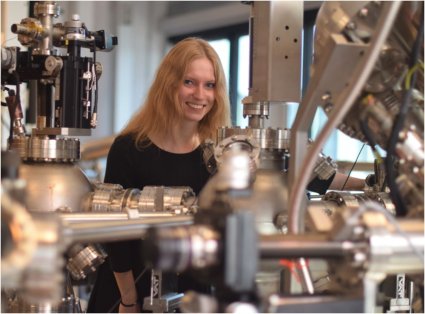Pushing a topological insulator to its ultrathin limit
Due to the COVID-19 crisis the PhD defence of Liesbeth Mulder will take place (partly) online.
The PhD defence can be followed by a live stream.
Liesbeth Mulder is a PhD student in the research group Interfaces and Correlated Electron Systems (ICE). Her supervisor is prof.dr.ir. A. Brinkman from the Faculty of Science and Technology (S&T).
 In the field of condensed matter physics, there is a never-ending interest to find new materials that host unique properties. The implementation of these newly found materials in the field of quantum computing might present a solution to the current challenges that the semiconductor industry is facing regarding the increasing demand for computational power. By incorporating topological insulators in this field, one would be able to utilise their topologically protected surface states, where the electron's propagation direction and spin are coupled by spin-momentum locking. Limiting the distance between opposite topological surfaces causes their wave functions to overlap and hybridise, giving rise to one-dimensional edge states. Only in this limit the forbidden backscattering imposed by the spin-momentum locking results in quantised, dissipationless transport.
In the field of condensed matter physics, there is a never-ending interest to find new materials that host unique properties. The implementation of these newly found materials in the field of quantum computing might present a solution to the current challenges that the semiconductor industry is facing regarding the increasing demand for computational power. By incorporating topological insulators in this field, one would be able to utilise their topologically protected surface states, where the electron's propagation direction and spin are coupled by spin-momentum locking. Limiting the distance between opposite topological surfaces causes their wave functions to overlap and hybridise, giving rise to one-dimensional edge states. Only in this limit the forbidden backscattering imposed by the spin-momentum locking results in quantised, dissipationless transport.
In light of our final goal, to push our material towards this low-dimensional limit, we aim to optimise the deposition of thin layers of the ternary chalcogenide three-dimensional topological insulator (Bi0.4Sb0.6)2Te3 by molecular beam epitaxy. On the one hand, this thesis aims to create the perfect platform to look for signatures of the quantum spin Hall effect. For this purpose we established a theoretical framework regarding the binary three-dimensional topological insulator materials. Experimentally, we investigated the influence of dissimilar InP (111)A, Al2O3 (001) and SrTiO3 (111) substrates on the morphological and structural properties of the (Bi0.4Sb0.6)2Te3 films. We found that the combination of vicinal Al2O3 (001) substrates and a post-anneal treatment results in high-crystalline, single domain films with a homogeneous height distribution. On the other hand, this thesis explores experimental methods such as angle-resolved photoemission spectroscopy, scanning tunnelling spectroscopy and magneto-transport measurements to investigate the electronic properties and verify the topological properties of (Bi0.4Sb0.6)2Te3 in its ultrathin limit.





